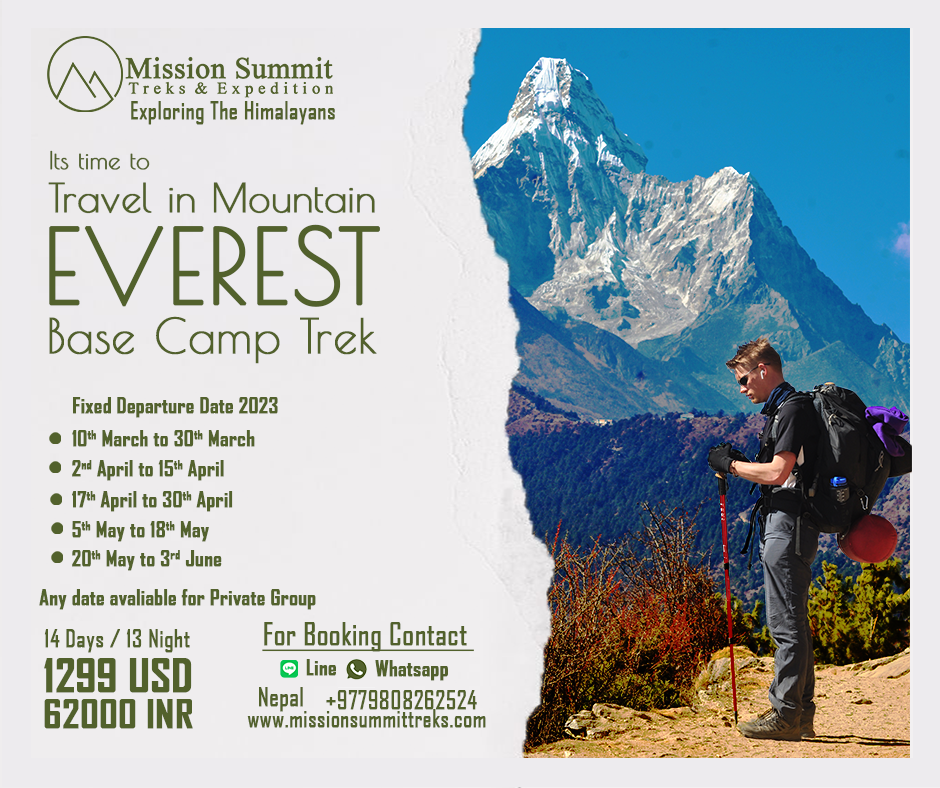The 12 Days Everest Base Camp trek is one of the most popular and sought-after treks in the world. Located in the Khumbu region of Nepal, the trek offers stunning views of the Himalayas, including the highest mountain in the world, Mount Everest. The trek is not only an adventure in itself, but it also offers a unique opportunity to experience the culture of the Sherpa people who inhabit the region.
The trek typically takes around 12-14 days, covering a distance of about 65 kilometers. The starting point of the trek is the town of Lukla, which is accessible by a short flight from Kathmandu. From there, the trail winds its way through the Sagarmatha National Park, a UNESCO World Heritage Site, which is home to a diverse range of flora and fauna.
The first few days of the trek involve a gradual ascent through the lush green forests and villages of the Khumbu region. The trail passes through small villages like Phakding and Monjo, where trekkers can experience the unique culture and lifestyle of the Sherpa people. The Sherpas are an ethnic group of people who are renowned for their mountaineering skills, and they have been instrumental in the success of many Everest expeditions.
As the trek progresses, the altitude increases, and the landscape changes dramatically. The trail becomes steeper and more rugged, with rocky terrain and glaciers becoming more prevalent. The highlight of the trek is undoubtedly reaching the Everest Base Camp, which is located at an altitude of 5,364 meters. The base camp serves as a starting point for many expeditions attempting to summit Mount Everest.
Reaching the base camp is no easy feat, and it requires a certain level of physical fitness and endurance. However, with the right preparation and mindset, the trek is achievable for most people. It is essential to acclimatize properly to the altitude and take enough time to rest and recover along the way.
Along the way, trekkers will encounter a variety of challenges and obstacles. One of the most significant challenges is the altitude, which can cause symptoms of altitude sickness. It is important to pay attention to your body and seek medical attention if necessary. The weather can also be unpredictable, and trekkers should be prepared for sudden changes in conditions.
Despite the challenges, the Everest Base Camp trek is a once-in-a-lifetime experience that is well worth the effort. The breathtaking views of the Himalayas, the unique culture of the Sherpa people, and the sense of accomplishment at reaching the base camp are all experiences that will stay with you for a lifetime.
One of the highlights of the trek is the opportunity to visit the Everest View Hotel, which is located at an altitude of 3,880 meters. The hotel offers stunning panoramic views of the Himalayas, including Mount Everest, and is a great place to take a break and soak in the scenery. The hotel is also a testament to the ingenuity of the Sherpa people, who built the hotel using traditional techniques and materials.
Another must-see attraction on the trek is the Tengboche Monastery, which is one of the most significant monasteries in the region. The monastery is located at an altitude of 3,867 meters and offers a glimpse into the spiritual and cultural traditions of the Sherpa people.
The Everest Base Camp trek is not just a physical challenge but also a cultural and spiritual journey. The trek offers a unique opportunity to learn about the Sherpa people and their way of life. Trekkers can visit local schools and monasteries and learn about the history and culture of the region.
In conclusion, the Everest Base Camp trek is an unforgettable experience that combines adventure, culture, and natural beauty. The trek is a great way to challenge yourself physically and mentally and to experience the
